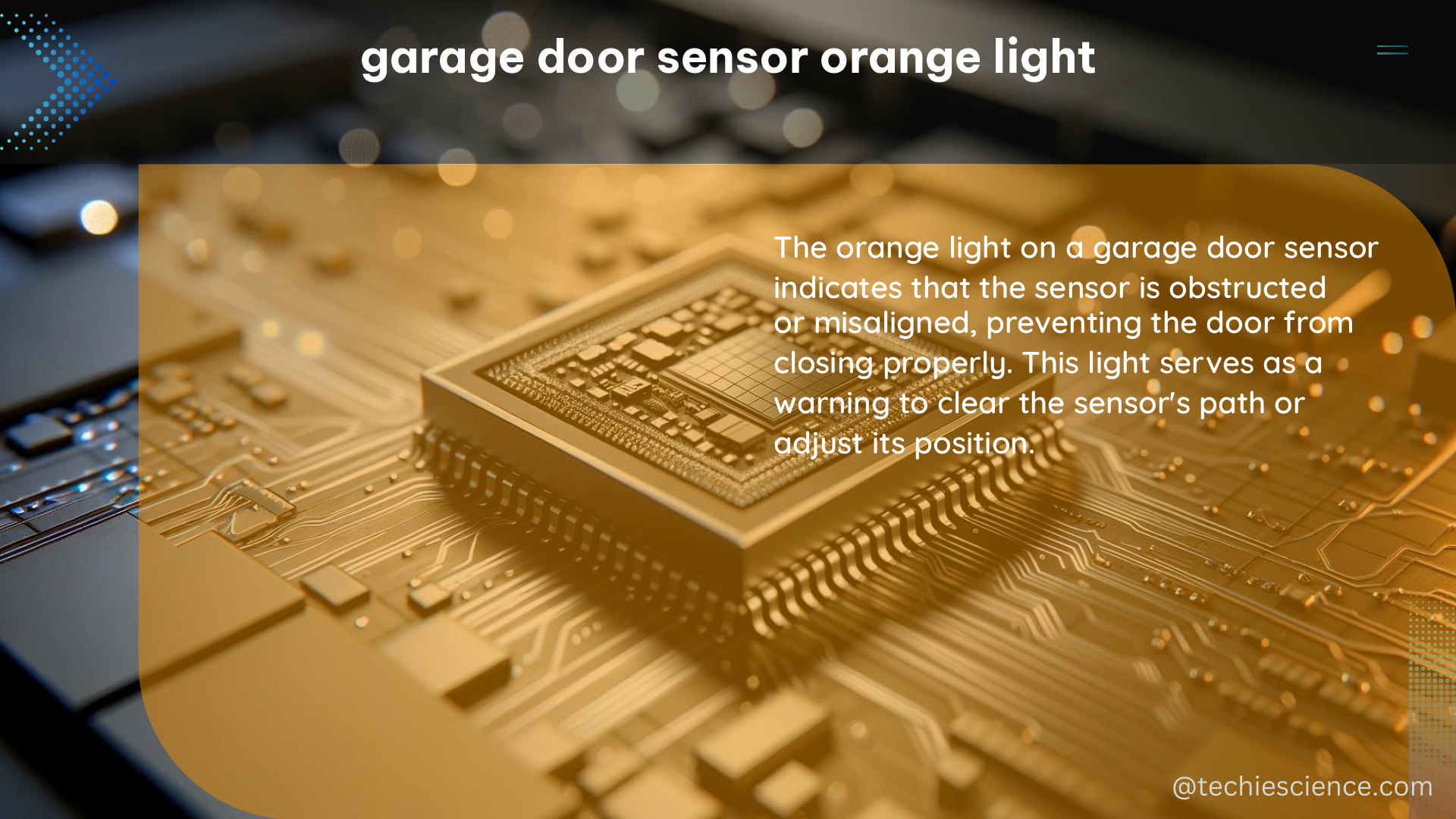Garage door sensors are crucial for the safe and efficient operation of automatic garage doors. These sensors emit a beam of light that is interrupted when an object is detected in the path of the closing door. When the sensors detect an issue, they may display an orange light. Here are some measurable and quantifiable data points related to the garage door sensor orange light:
Power Consumption
Garage door sensors typically consume very little power, often in the range of 10-50 milliwatts. This low power consumption allows them to operate efficiently and without draining the power source excessively.
Detection Range

The detection range of garage door sensors can vary, but they typically have a range of 6-12 inches. This range is designed to detect objects in the immediate vicinity of the closing door, ensuring the safety of both people and objects.
Response Time
The response time of garage door sensors is usually less than 1 second. This means that if an object enters the sensor’s path, the sensor will detect it and stop the door from closing within a very short time frame, preventing potential damage or injury.
Operating Environment
Garage door sensors are designed to operate in a wide range of temperatures, typically from -20°F to 120°F (-29°C to 49°C). This wide temperature tolerance ensures that the sensors can function reliably in various climatic conditions.
Wire Length
The length of the wires connecting the sensors to the garage door opener can vary, but they are typically around 10-20 feet (3-6 meters). This allows for flexibility in the placement and installation of the sensors.
Alignment Tolerance
The alignment tolerance of garage door sensors is typically around 1/8 inch (3 millimeters). This means that the sensors must be aligned within this tolerance in order to function properly and accurately detect objects in the door’s path.
Lens Diameter
The lens diameter of garage door sensors is typically around 1/2 inch (12 millimeters). This is the size of the lens through which the sensor’s infrared beam is emitted and received, allowing for precise detection of objects.
Field of View
The field of view of garage door sensors is typically around 30 degrees. This means that the sensor can detect objects within a cone-shaped area in front of the sensor, providing a wider coverage area for detection.
Sensor Type
Garage door sensors can be either photoelectric or ultrasonic. Photoelectric sensors use a beam of light to detect objects, while ultrasonic sensors use sound waves. The choice of sensor type can depend on the specific requirements of the garage door system.
LED Lifespan
The LEDs used in garage door sensors typically have a lifespan of around 100,000 hours. This long lifespan ensures that the sensors can operate reliably for an extended period without the need for frequent LED replacements.
Garage Door Sensor Orange Light: DIY Tips and Tricks
If you are experiencing issues with your garage door sensor and it is displaying an orange light, here are some DIY tips and tricks that you can try:
-
Check for Obstructions: Make sure that there are no objects blocking the path of the sensors. Even small objects like leaves or pebbles can cause the sensor to malfunction.
-
Verify Sensor Alignment: Ensure that the sensors are properly aligned with each other. They should be facing each other directly, and their beams should be unobstructed.
-
Clean the Sensors: Dust, dirt, and spider webs can accumulate on the sensors over time, affecting their performance. Gently clean the sensors using a soft, dry cloth to remove any debris.
-
Inspect the Wiring: Faulty or damaged wiring can cause the garage door sensor to malfunction. Examine the wires connected to the sensors and ensure that they are securely attached and undamaged.
-
Check Power Source: Make sure that the power source is properly connected and supplying adequate power. Check for any loose connections or blown fuses in the circuit.
-
Reset the Sensors: Resetting the sensors can often resolve minor issues and restore their normal operation. Refer to the manufacturer’s instructions on how to reset your specific garage door sensor.
By following these DIY tips and understanding the technical specifications of your garage door sensors, you can troubleshoot and resolve issues related to the orange light, ensuring the safe and reliable operation of your automatic garage door.
References:
– How to Fix Orange Light on Garage Door Sensor
– How do I get my garage to close? One sensor is orange
– Garage Door Sensor Troubleshooting
– Garage Door Sensor Alignment
– Garage Door Sensor Lights Color Meaning

The lambdageeks.com Core SME Team is a group of experienced subject matter experts from diverse scientific and technical fields including Physics, Chemistry, Technology,Electronics & Electrical Engineering, Automotive, Mechanical Engineering. Our team collaborates to create high-quality, well-researched articles on a wide range of science and technology topics for the lambdageeks.com website.
All Our Senior SME are having more than 7 Years of experience in the respective fields . They are either Working Industry Professionals or assocaited With different Universities. Refer Our Authors Page to get to know About our Core SMEs.